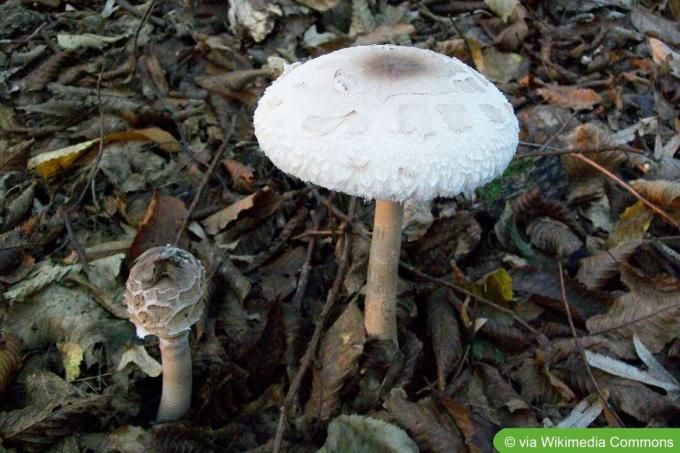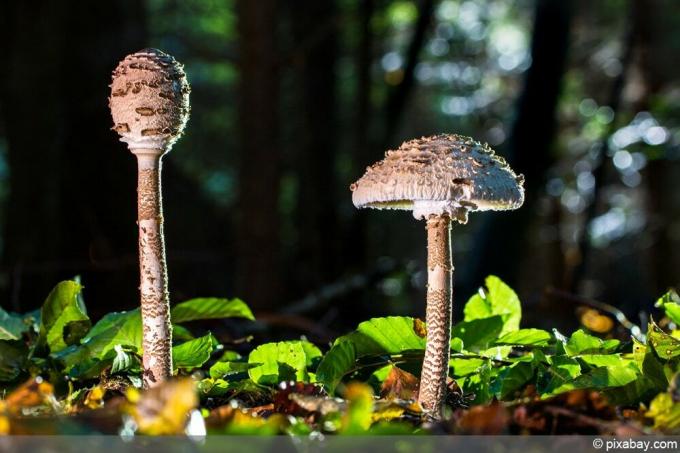

Table of contents
- White mushrooms in the garden from B to G
- From J to M
- From R to W
- frequently asked Questions
White or whitish mushrooms can appear in various places in the garden. This article is intended to help identify them more easily. However, since fungi are very changeable, a certain amount of caution is always advisable.
White mushrooms in the garden from B to G
Tufted Egerling (Leucoagaricus americanus)

This fungus often appears in groups that are fused at the base. The fruiting bodies are not yet white when young.
- Cap: up to 12 cm wide, brownish when young, white with reddish scales when older, thin-fleshed, white to yellowish lamellae
- Stem: ringed, whitish above, brownish below, flesh yellowing, then reddening
- Taste: mild
- Odor: fungus
- Occurrence: July to September, in the garden on the compost, scraps of wood or bark mulch
- Edible value: controversial, suspected of being poisonous
- Risk of confusion: other parasols, mushrooms
A notice:
Only collect mushrooms that you really know!
Poison Saffron Parasol (Chlorophyllum venenatum)
Like many other types of mushrooms, this mushroom is tolerated by some people but not by others. Under certain circumstances, it triggers severe gastrointestinal disorders.
- Cap: up to 18 cm wide, light to brownish, covered with many scales
- Stem: white, squat, with a tuber, ring with a double edge, flesh white, tinged with red, lamellae white
- Taste: unpleasant
- Odor: unpleasant
- Occurrence: August to October, on nutrient-rich soil, not common
- Edible value: poisonous
- Danger of confusion: edible giant parasols like the parasol
Squat mushroom (Agaricus litoralis)
In principle, this mushroom is edible, but can sometimes have such an unpleasant smell that you do not want to eat it.
- Cap: up to 8 cm across, white with brownish scales, flat crown; whitish, later reddish brown lamellae
- Stem: squat, with a ring, light to purple above, light below, club-shaped, flesh firm, reddening
- Taste: mild
- Odour: neutral, sometimes unpleasant
- Occurrence: June to September, in meadows, often in groups, rarely
- Food value: inedible
- Likelihood of confusion: other mushrooms
Girdled mushroom (Agaricus subperonatus)

Older specimens of this mushroom should no longer be eaten. Not only because they smell and taste unpleasant, but also because they can cause gastrointestinal disorders.
- Cap: up to 12 cm wide, grey-white, dark scales, lamellae first pink and later brownish
- Stem: elongate, serpentine, with a ring zone, light and smooth above, light with remains of vellum below, flesh tinged pink
- Taste: fungus when young, unpleasant when old
- Smell: pleasantly fruity when young, fishy when older
- Occurrence: May to October, loose, humus-rich soil, rare
- Food value: edible
- Likelihood of confusion: other mushrooms
Large parasol (Macrolepiota procera)

The parasol is one of the largest native mushrooms. The hat can be breaded and fried like a schnitzel.
- Cap: up to 30 cm wide, white with brownish scales, white lamellae
- Stem: long, light with clear brownish serrations, ring double, thick, movable
- Taste: nutty, mild
- Odour: nutty
- Occurrence: July to November, often in meadows
- Food value: edible
- Danger of confusion: other giant parasols
A notice:
If you pay attention to the movable ring, this species is difficult to confuse with other mushrooms because of its size.
Greater Scheibel (Volvariella gloiocephala)

Because of the risk of confusion with death cap mushrooms, the Ackerscheidling should not be eaten.
- Cap: up to 15 cm wide, white to greyish, glabrous, sometimes sticky, lamellae white, later brownish
- Stem: long, glabrous, whitish, with whitish sheath
- Taste: mild, like radish
- Odour: mushroomy, radish-like
- Occurrence: May to October, on fertilized soil, often also in fields
- Food value: edible
- Danger of confusion: sheath strippers, death cap mushrooms (deadly poisonous!), other sheaths
Large-spored mushroom (Agaricus urinascens)

This mushroom is one of the largest representatives of its kind. Because of this, it is difficult to confuse this white fungus in the garden with poisonous specimens.
- Cap: up to 25 cm wide, white, older slightly yellowish, glabrous, lamellae are greyish when young, later brownish
- Stem: squat, white, with a ring, surface finely flaky, flesh only tinges saffron in the stem area
- Taste: mild
- Odour: aniseed, unpleasant with age
- Occurrence: August to October, in meadows, rare
- Food value: edible
- Likelihood of confusion: other mushrooms
From J to M
Maiden Ellerling (Cuphophyllus virgineus)

A distinctive feature of this species is its translucent flesh. Although this white fungus is edible, care should be taken not to eat it raw.
- Cap: up to 6 cm wide, whitish translucent, apex sometimes somewhat yellowish, white lamellae
- Stem: white, slender, acuminate, flesh white
- Taste: neutral
- Odour: mild
- Occurrence: September to November, in mossy meadows
- Food value: edible
- Confusion risk: with other Ellerlingen (different smell), funnellets (some poisonous)
Carbolic Mushroom (Agaricus xanthodermus)

You can contact this user here.
English | espanol | french | italiano | macedonian | മലയാളം | portuguese | +/−, 2012-04-19 Agaricus xanthodermus Genev 213787, Edited by Home Garden, CC BY-SA 3.0
This mushroom species is one of the few that are poisonous. Be sure to pay attention to the ink-like smell and the yellowing stem base of this white fungus.
- Cap: up to 15 cm wide, white to greyish, lamellae pink, later brown
- Stem: white with ring, smooth, flesh yellowing
- Taste: unpleasant
- Odour: like ink
- Occurrence: May to October, on meadows, but also in the forest
- Edible value: poisonous
- Risk of confusion: with other types of mushrooms
A notice:
A final note of caution is the discoloration of this mushroom when cooked. It turns completely yellow.
Smallest wood crustacean (Volvariella pusilla)

Because of its small size, this white mushroom is often overlooked in the garden lawn.
- Cap: up to 3 cm wide, white, fibrous, lamellae white, later pink
- Stem: white, glabrous, with a whitish sheath
- Taste: slightly sweet
- Odour: mild
- Occurrence: June to September, on fertilized meadows, rare
- Edible value: considered inedible, but non-toxic
- Risk of confusion: with other small Scheidlingen
May mushroom (Calocybe gambosa)

As its name suggests, this white fungus grows very early in the year. However, its floury taste can be very pronounced and unpleasant.
- Cap: up to 10 cm across, white to yellowish, thick flesh, lamellae white, later yellowish
- Stem: thick, white, glabrous
- Taste: mild, mealy
- Odour: floury to cucumber-like
- Occurrence: April to June, damp meadows
- Food value: edible
- Risk of confusion: brick-red crack fungus (poisonous, pay attention to the lack of flour smell)
From R to W
Giant Puffball (Calvatia gigantea)

Due to its shape and size, this mushroom is almost unmistakable. This white fungus is often sedentary, meaning it reappears in the same place every year.
- Fruit bodies: up to 50 cm in diameter, white when young, later yellowish, flesh firm, later becoming soft
- Taste: mild
- Odor: unpleasant, old urine-like
- Occurrence: July to October, on fertilized meadows
- Food value: edible as long as the flesh is white and firm
- Risk of confusion: young, small specimens with other puffballs
Giant Brimmed Funnel (Leucopaxillus giganteus)

This white fungus can kill the grass in the garden, but this is only a temporary phenomenon.
- Cap: up to 30 cm wide, white, funnel-shaped, notched edge, white lamellae, close together
- Stem: white, very short, smooth and glabrous, flesh white
- Taste: mild, nutty
- Odour: mealy, mushroomy
- Occurrence: August to October, in meadows, often in large witch rings
- Food value: edible
- Risk of confusion: impossible in the garden, otherwise with fog cap or monk's head
Ink Cap (Coprinus comatus)

The ink cap is a very ephemeral mushroom that turns black and melts within a short time.
- Cap: up to 12 cm high, white with dark scales when young, soon turning dark
- Stem: white, long, thin, lamellae white, then reddish to black
- Taste: mushroomy, mild
- Odor: fungus
- Occurrence: May to November, often on fertilized meadows
- Edible value: edible as long as white and tightly closed cap
- Risk of confusion: possibly with other Tintlingen
White death cap (Amanita phalloides var. alpha)

Although this white fungus is not that common in the garden, it is included here because it can be confused with edible mushrooms.
- Cap: up to 10 cm wide, white, glabrous or with white flakes
- Stem: white, serpentine, with white sheath, flesh white
- Taste: don't taste!, is described as mild
- Odour: sweet, mild
- Occurrence: June to August, in gardens near deciduous trees
- Edible value: deadly poisonous
- Risk of confusion: always be careful with cuttings, mushrooms (no white lamellae), with pure white mushrooms!
Meadow mushroom (Agaricus campestris)

The meadow mushroom is one of the typical mushrooms that are usually easy to recognize. The pink lamellae are important.
- Cap: up to 8 cm wide, white, flat, mostly without scales, lamellae pink when young, later brown
- Stem: white, slender, ring barely developed, flesh tinged pink
- Taste: mild, nutty
- Odor: fungus
- Occurrence: May to October, on fertilized meadows
- Food value: edible
- Risk of confusion: death cap mushroom (toxic), carbolic mushroom (toxic), other mushrooms
frequently asked Questions
Basically, mushrooms grow in all sorts of places. In the garden, they can therefore be found on dead deciduous or coniferous wood, on wooden fences, in meadows and in the lawn, on the compost, in the greenhouse or in the cold frame happen.
There are different reasons for this. Fungal spores spread everywhere, completely invisible. The mycelium then grows unnoticed for days or months, for example in the ground or in wood, and if the weather is right, the visible fruiting bodies supposedly appear suddenly.
Mushrooms are neither a good nor a bad sign. Fungi that depend on a lot of moisture can indicate that the lawn is too wet. Other species that require a lot of nutrients indicate that the lawn may be over-fertilized. Fungi rarely damage grasses, and if they do, removing the fruiting bodies will not prevent it, as the mycelium in the soil is responsible for the damage.
 Mirko
Mirko
Learn more about mushrooms - types and varieties

Mushroom season: when do which mushrooms grow?
There are countless species of mushrooms that grow wild in nature. In terms of taste, everyone has their preferences. Mushroom pickers and those who would like to become one can find out when which mushrooms grow and are in season here with us.

Collect, prepare and dry porcini mushrooms | All information about the porcini mushroom
Porcini mushroom hunt made easy! Here you can find out where and when it is best to search for the popular edible mushroom. In addition, we give you helpful tips for further processing, preservation and storage!

Grow truffles yourself – this is how you grow the mushroom specialty
Truffles were thought to be extinct in Germany for a long time, but they are actually still wild. They are protected, so they may not be collected. On the other hand, cultivation and harvesting are permitted on one's own land - not that difficult.

Parasol mushroom - is it poisonous? How to recognize him correctly
In the article you will learn why the parasol mushroom is definitely not poisonous, but was voted "edible mushroom of the year 2017" for good reason.

Popular Forest Mushrooms – Recognizing Edible Mushrooms + Photos
Collecting forest mushrooms is very popular. When preparing in the kitchen, many recipes invite you to try out different dishes. For many mushroom pickers, staying in the great outdoors is another important reason for this beautiful hobby. Wild mushrooms are tasty and safe if you know your stuff. It is important that you can confidently distinguish an edible mushroom from a toadstool.

Ball Tree: Care from A – Z | These 9 varieties are suitable for ball trees
Ball trees adorn many a garden, front yard and entrance area. They require little space. Their trunk thickens with age, but its height remains the same. The spherical crown is easy to trim. Nevertheless, they offer everything that makes a tree.



